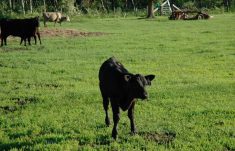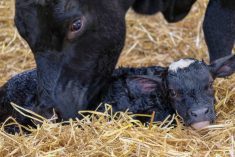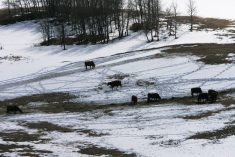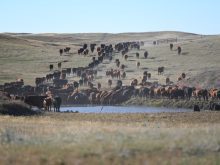For much of this summer a lot of rain has fallen across the Prairies and has made pastures lush with green grass. Many beef cow-calf producers which creep spring calves have found cows are literarily bursting with milk, so their spring calves are making few visits to the calf feeders.
It has been my experience eventually calves will come up and eat more creep feed. That’s because by late summer, milk production of the nursing cow naturally slows down and will make up about 50 per cent of her calf’s growing requirements. Lush pastures will also mature and lay down more fibre, which limits available nutrients for good calf growth. By creep feeding calves, supplemental feed not only fills this nutritional gap, but can make for a more profitable calf at weaning.
Read Also

Harvest wraps up and fall work begins
At the Eppich famly ranch in western Saskatchewan, the fall harvest was successful with few breakdowns, cows and calves have been sorted and a new tractor has arrived
Good return four out of five years
For many people, creep feeding calves must be profitable even before they consider it. In the last five years of creep feeding in Western Canada, the picture shows four positive annual return on investment (ROI) (2012-15) and only one negative ROI year (2011). The biggest ROI of 142 per cent was set last fall.
For 2016, I present the following spreadsheet. It illustrates the current financial status of a 100-day creep feeding program implemented for a group of large-framed calves with standard genetics and replacement heifers segregated to another pasture put on a different feeding program. Other parameters include: 1. A commercial 14 per cent creep feed pellet @ $350/mt is fed, 2. Feed conversion of these pellets is six lbs. of weaned weight gain, 3. All calves are weaned at 600 lbs. and 4. A cwt market discount of five cents per lb.
I showed these calculations to a friend who operates a 300-cow-calf operation. He said that $25 per calf didn’t seem much profit, if you could get them to eat creep feed in the first place. But I disagreed with him. Even in a flat or down cattle market; my current calculation of his 350 cows x 96 per cent calving rate x 90 per cent marketable calves (replacement heifers held back) x $25.53 per weaned calf yields about $6,600.
By looking at this absolute profit of nearly $7,000, it didn’t take my friend long to envision the worthiness of creep feeding his calves, once they are dramatically eat eight to 10 lbs. per day by summer’s end and well into the fall months. His creep feeders and others should be filled with a nutritious well-balanced creep feed; 14 per cent protein, medium level energy (65-70 per cent TDN), balanced with calcium, phosphorus, salt, fortified trace mineral-vitamin pack (especially copper, zinc, selenium, vitamin A and vitamin E). A probiotic or yeast plus a coccidiostat such as monensin sodium should also be added to the final creep formula.
Gain without fat
I use these nutrient guidelines to put together practical creep feeding feeds and programs that put efficient gains (complement milk and forage intake) on spring calves without making them “fleshy or greasy.” That means I like to formulate beef calf creep feeds using some barley, wheat middling, corn distillers’ grains and soybean meal. I avoid sunflower and canola meal due to lower palatability and most feed screenings due to low feed quality and high risk of mycotoxins, although good-quality pea and lentil screenings are acceptable. I do this work in conjunction with local feed mills and get a commercial pellet made, which has a five to six per cent feed consumption advantage over chop feed when fed to spring calves.
Creep feeding is still significantly utilized by many cow-calf producers as a means of supplementing essential nutrients to saleable beef calves, where milk and forage supplies become short. Despite lower selling prices projected for weaned calves this fall, those producers committed to putting calf creep feeders out on pasture should squeeze out on profitable creep feeding in 2016.

















